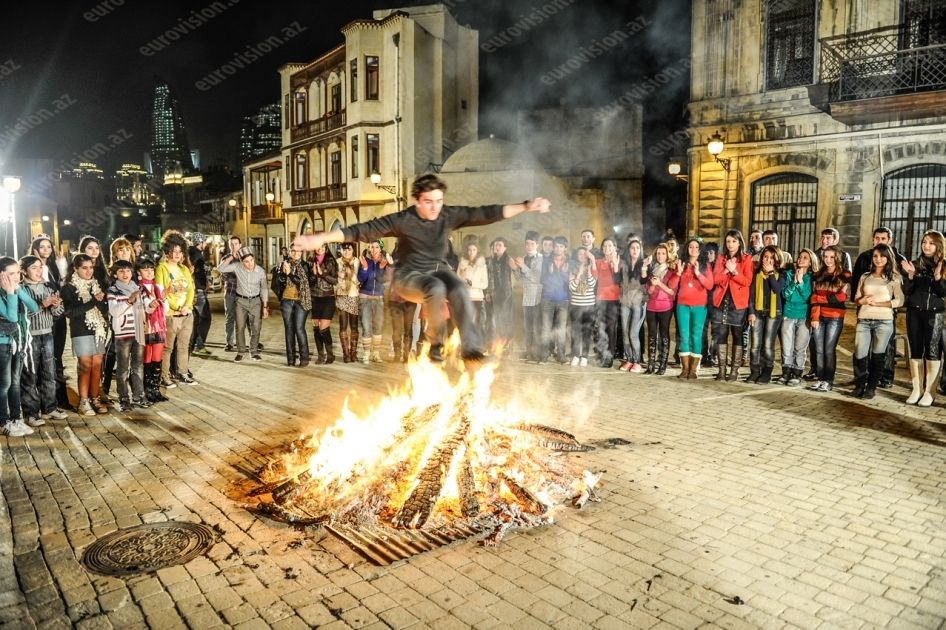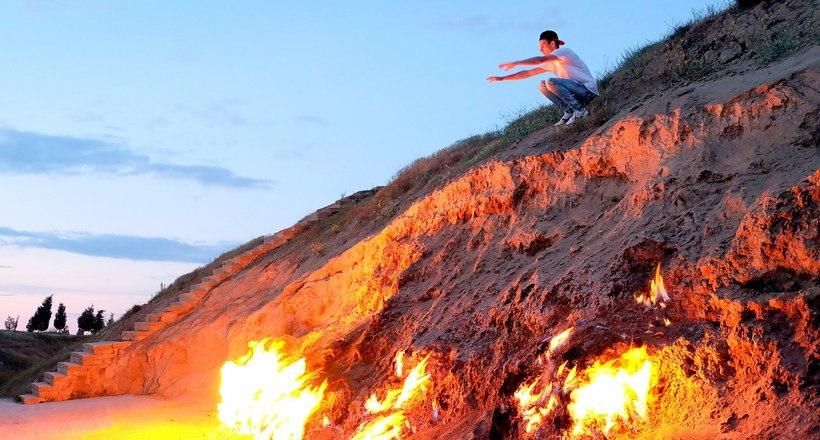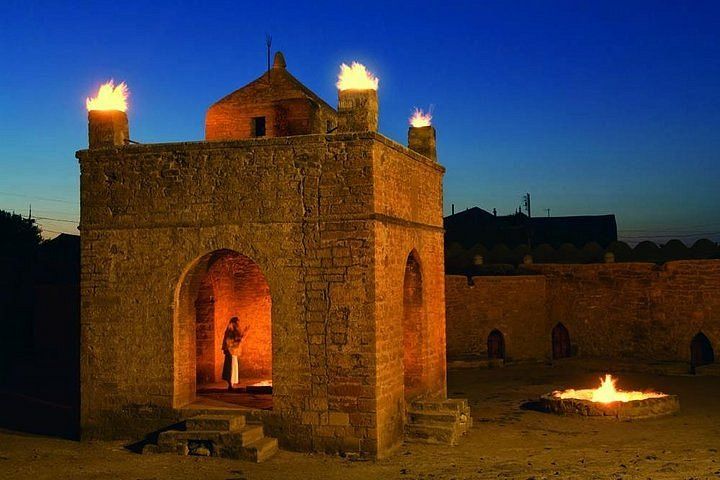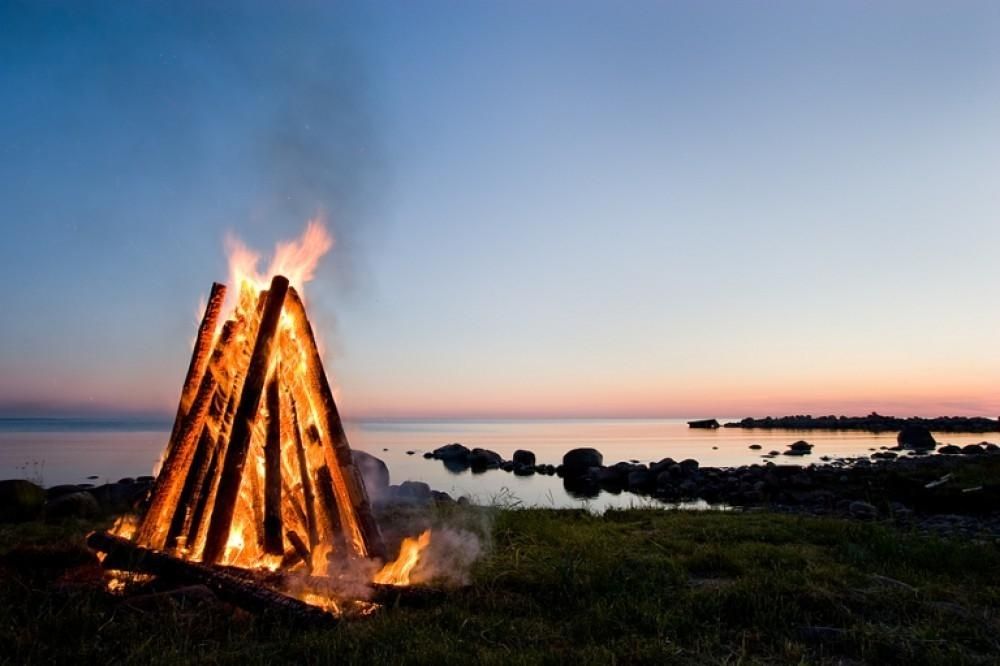|
|
TODAY.AZ / Weird / Interesting
Azerbaijani people recall centuries-old traditions associated with Fire element
05 March 2024 [16:39] - TODAY.AZ
 Laman Ismayilova
Laman Ismayilova
In anticipation of the Novruz spring holiday, the Azerbaijani people recall the centuries-old traditions associated with the four elements of the universe: Water, Fire, Earth and Air.
The four Tuesdays before the Novruz holiday symbolise the four elements: Su Charshanbasi (Water Tuesday), Od Charshanbasi (Fire Tuesday), Torpaq Charshanbasi (Earth Tuesday), and Hava or Akhir Charshanba (Wind or Last Tuesday). Each Tuesday has its own traditions, Azernews reports.
Everlasting fire sources have long been a source of fame for Azerbaijan.
On this day, Azerbaijanis light bonfires in their courtyards and public spaces, jumping over the flames to symbolise the leaving behind of winter's cold and darkness.

The tradition of celebrating Fire Tuesday dates back to ancient Zoroastrian beliefs, where fire was seen as a symbol of purification and renewal.
Zoroastrianism was founded by Zoroaster (who claimed to be a prophet) in ancient Iran approximately 3,500 years ago and revolves around the worship of fire.
The Absheron Peninsula and Baku were centres of Zoroastrianism in ancient times. Four centuries-old traditions and beliefs. Its traces can be found in the Baku, Shamakhi, Nakhchivan, Mingechaur, and Talysh-Mugan areas.
One of the most famous and popular tourist attractions of the "eternal flame" in Azerbaijan is Yanar Dag.

This magical place is associated with many legends. Since ancient times, fire worshippers have gathered in these places.
Yanar Dag is a natural gas fire that blazes continuously on a hillside on the Absheron Peninsula on the Caspian Sea near Baku.
Unlike mud volcanoes, the Yanar Dag flame burns fairly steadily, as it involves a steady flow of gas from the subsurface. The flames emanate from vents in sandstone formations and rise to a height of 10 metres.
Ateshgah, or Fire Temple, is another significant Zoroastrian site in Azerbaijan.
Constructed in the 17th and 18th centuries, this temple is an ancient Hindu castle-like religious edifice in a suburb of greater Baku that was initially recognised as a Zoroastrian fire worship place.

Moreover, Azerbaijan's ancient epic "The Book of Dede Gorgud" provides insight into the fire's role in the history of the Oghuz Turks.
Even the number of fires lit had specific symbolism. If one fire was lit on a high hill, it called for unity among the Oghuz Turks; two fires warned of danger over their native land and called for a fight against the enemy, but if three fires were lit over the mountain, this meant victory over the enemy and national triumph.
A similar respect given to the fire element can be traced in the rituals associated with the Novruz holiday.
According to the ancient beliefs of Azerbaijanis, once a year, the spirits of deceased ancestors visited their children, grandchildren, and great-grandchildren.
This arrival coincided with the last Tuesday of the year. If the spirits of the dead saw that there was no light (fire) burning in the hearths they left behind, then they left, offended by their descendants, and never returned. According to this belief, on the last Tuesdays of the outgoing year, bonfires were lit, around which the whole family gathered, jumped over the fire, and asked the Creator for health and prosperity.
Today, Fire Tuesday, is a festive occasion marked by dancing, singing, and feasting with family and friends.
One of the most popular traditions on Fire Tuesday is the preparation and consumption of a special dish like pilaf with beans or chicken.
Fire Tuesday is a joyous and colourful celebration that brings people together to welcome the arrival of spring.

URL: http://www.today.az/news/interesting/245603.html
 Print version
Print version
Connect with us. Get latest news and updates.
See Also
- 19 February 2025 [22:20]
Visa and Mastercard can return to Russia, but with restrictions - 05 February 2025 [19:41]
Japan plans to negotiate with Trump to increase LNG imports from United States - 23 January 2025 [23:20]
Dubai once again named cleanest city in the world - 06 December 2024 [22:20]
Are scented candles harmful to health? - 23 November 2024 [14:11]
Magnitude 4.5 earthquake hits Azerbaijan's Lachin - 20 November 2024 [23:30]
Launch vehicle with prototype of Starship made its sixth test flight - 27 October 2024 [09:00]
Fuel prices expected to rise in Sweden - 24 October 2024 [19:14]
Turkiye strikes terror targets in Iraq and Syria - 23 October 2024 [23:46]
Kazakhstan supplied almost entire volume of oil planned for 2024 to Germany in 9 months - 23 October 2024 [22:17]
Taiwan reported passage of Chinese Navy aircraft carrier near island
Most Popular
 Paraguay designates Hamas, Hezbollah, Iranian Guards as terrorist organizations
Paraguay designates Hamas, Hezbollah, Iranian Guards as terrorist organizations
 Türkiye becomes strategic partner in Three Seas Initiative
Türkiye becomes strategic partner in Three Seas Initiative
 Baku court reviews video alleging criminal Ishkhanyan blocked Azerbaijani troops from reaching Shusha
Baku court reviews video alleging criminal Ishkhanyan blocked Azerbaijani troops from reaching Shusha
 Ankara vows no compromise on national interests amid Greek Cypriot provocations
Ankara vows no compromise on national interests amid Greek Cypriot provocations
 Azerbaijan, Kazakhstan begin talks on new double taxation agreement
Azerbaijan, Kazakhstan begin talks on new double taxation agreement
 Azerbaijani youth representative highlights green innovation and leadership at UN ECOSOC Youth Forum
Azerbaijani youth representative highlights green innovation and leadership at UN ECOSOC Youth Forum
 British civil servants lost more than 3,000 phones and laptops in year
British civil servants lost more than 3,000 phones and laptops in year
